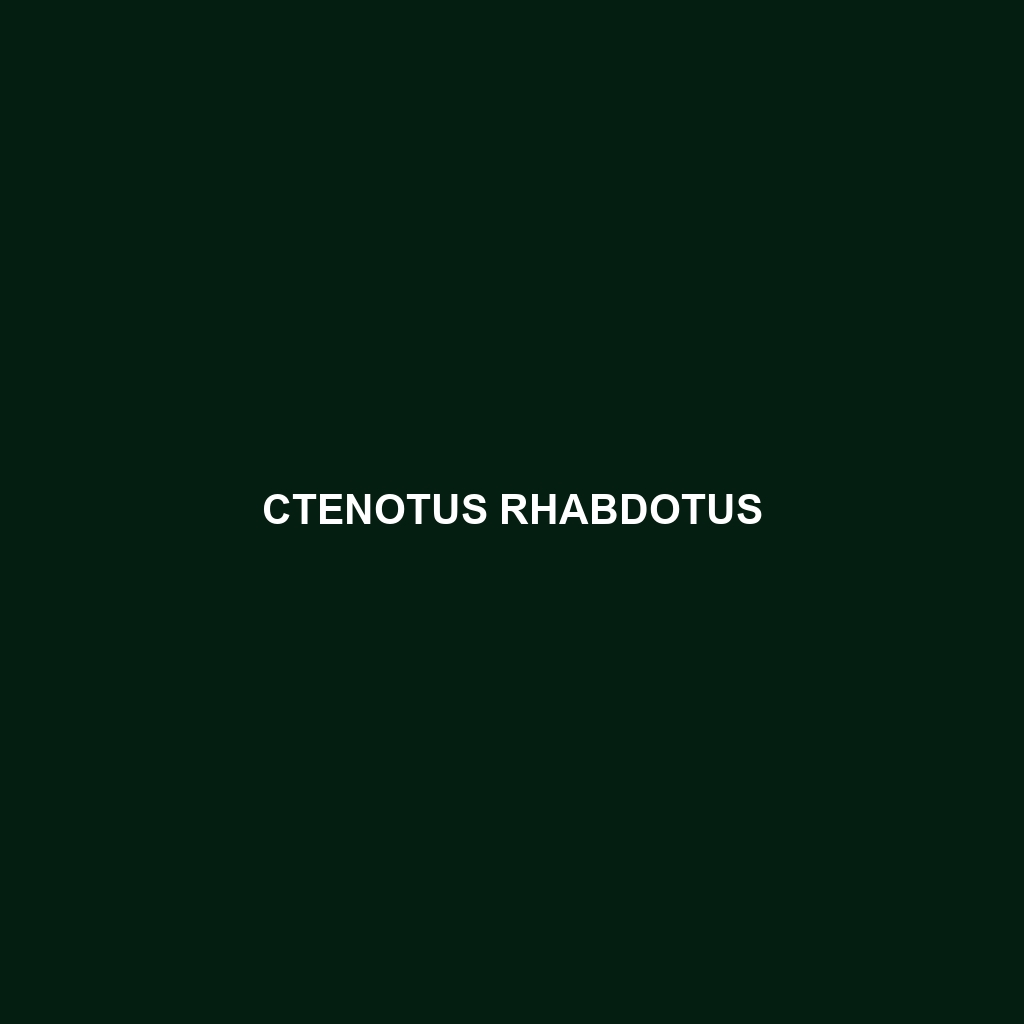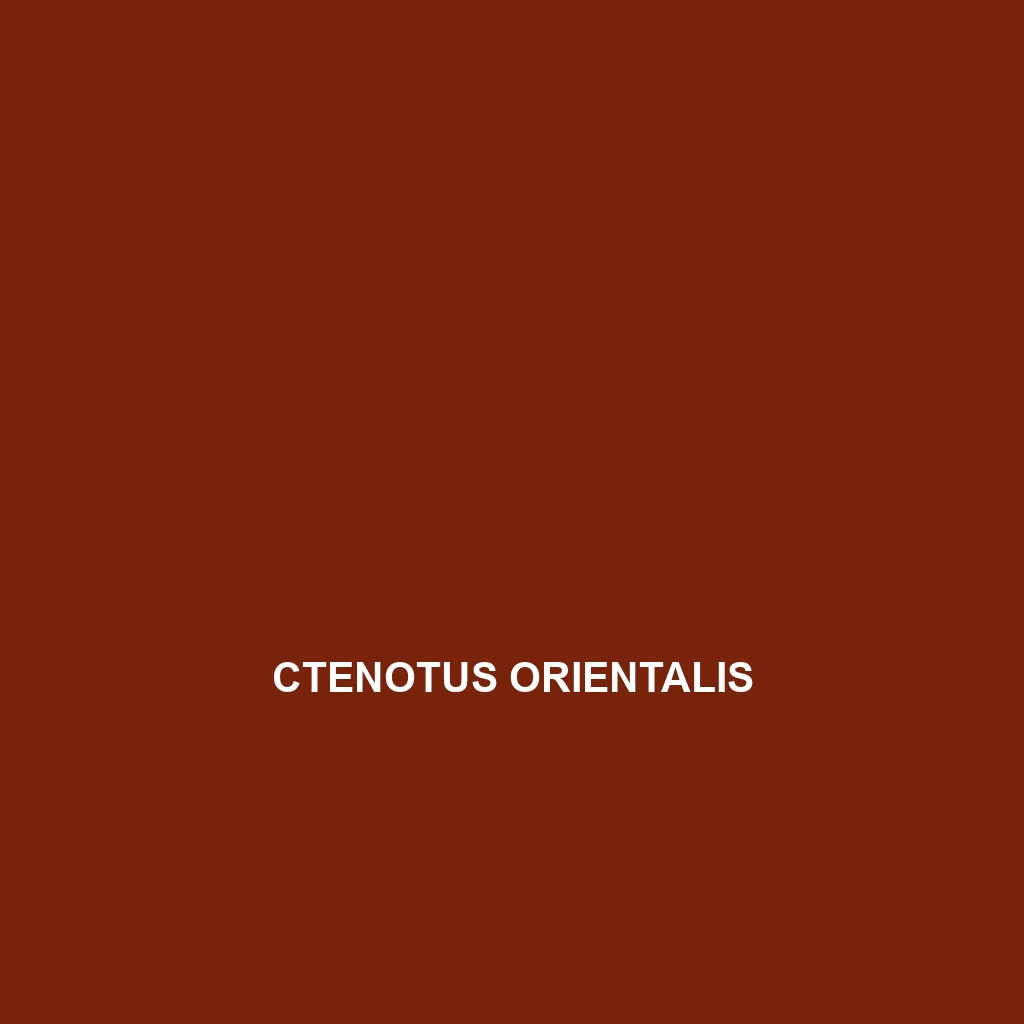-

Ctenotus rufescens
Discover the Ctenotus rufescens, or rufous ctenotus, a resilient Australian lizard measuring 10 to 15 cm, known for its distinctive light brown to reddish-brown coloration and streamlined body. Thriving in arid environments, this carnivorous species plays a vital role in controlling insect populations while showcasing impressive burrowing and territorial behaviors during its active diurnal and…
-

Ctenotus rhabdotus
Discover the Stripe-tailed Ctenotus (Ctenotus rhabdotus), a unique Australian lizard known for its striking dark stripes, agile movements, and insectivorous diet. Thriving in grasslands and woodlands, this diurnal species plays a crucial role in its ecosystem while exhibiting fascinating behaviors and impressive speed.
-

Ctenotus regius
Discover the royal ctenotus (Ctenotus regius), a slender-bodied lizard native to Australia’s arid regions, known for its striking coloration and quick, agile movements. This fascinating insectivorous species plays a crucial role in its ecosystem, contributing to insect population control while adapting to its harsh environment.
-

Ctenotus orientalis
Discover the Eastern Ctenotus (Ctenotus orientalis), a slender lizard native to southeastern Australia, thriving in scrublands and woodlands. With its distinct sandy brown and grey coloration, this diurnal species plays a vital role in controlling insect populations while showcasing fascinating behaviors and rapid growth rates.
-

Ctenotus ora
Discover the Ctenotus ora, an agile sand skink native to Australia’s arid regions, characterized by its light brown to grey coloration, distinctive darker stripes, and insectivorous diet. This diurnal lizard plays a vital role in its ecosystem, controlling insect populations while serving as prey for various predators.
-

Ctenotus maryani
Ctenotus maryani, commonly found in arid regions of Australia, is a slender lizard known for its distinctive earthy coloration and agile movements. This carnivorous species primarily feeds on small insects, playing a crucial role in its ecosystem by regulating insect populations while demonstrating fascinating thermoregulatory behaviors.
-

Ctenotus lancelini
Discover the Ctenotus lancelini, a slender lizard native to southeastern Australia, thriving in open woodlands and scrublands. With a length of 10 to 15 cm, it features distinctive light brown to golden coloration and plays a crucial role in controlling insect populations.
-

Ctenotus ingrami
Discover Ctenotus ingrami, commonly known as Ingram’s ctenotus, a medium-sized lizard native to arid regions of Australia, featuring a distinctive light brown to ochre coloration. This diurnal insectivore thrives in sandy or rocky habitats, playing a vital role in controlling insect populations while showcasing unique social behaviors during mating seasons.
-

Ctenotus hanloni
Ctenotus hanloni, a slender lizard native to the arid regions of Australia, measures 10 to 15 centimeters in length and features a distinctive striped pattern. Primarily insectivorous and diurnal, this species is known for its territorial behavior, ability to regenerate its tail, and vital role in maintaining ecosystem balance.
-

Ctenotus delli
Discover the captivating Ctenotus delli, a slender, diurnal lizard native to Australia’s arid regions, known for its sandy brown to olive coloration and effective camouflage. This insectivorous species plays a vital role in its ecosystem by regulating insect populations and serves as prey for larger predators, reflecting a healthy habitat.
Search
Popular Posts
-
Lygosoma corpulentum
Discover the Lygosoma corpulentum, or fat skink, a robust insectivorous lizard native to Southeast Asia’s moist tropical rainforests and varying habitats. With a stocky body, impressive camouflage, and remarkable adaptability, this ovoviviparous species plays a crucial role in maintaining ecological balance.
-
Lygosoma boehmei
Lygosoma boehmei is a slender, nocturnal insectivore found in humid tropical rainforests and savannas of Southeast Asia, exhibiting a smooth, camouflaging texture and remarkable burrowing abilities. This vulnerable species plays a crucial role in its ecosystem by controlling insect populations and serving as prey for larger predators.
-
Lygosoma bampfyldei
Lygosoma bampfyldei, commonly found in tropical and subtropical regions, is a moderately sized lizard measuring 15 to 25 cm, known for its elongated body and glossy, camouflage coloration. This insectivorous species thrives in moist habitats and plays a vital role in maintaining ecological balance by controlling insect populations.
Categories
Tags
animal adaptations (924) animal behavior (5000) animal reproduction (865) behavior (920) biodiversity (7853) conservation (1670) conservation efforts (1778) conservation status (5748) diet (2104) ecological balance (2087) ecological role (1952) ecosystem (1469) ecosystem role (2901) endangered species (2514) habitat (3280) habitat conservation (1136) Habitat Destruction (1421) habitat loss (3385) herpetology (870) insectivorous reptiles (948) IUCN Red List (1971) lizard behavior (881) lizard diet (944) lizard reproduction (1101) nocturnal animals (2754) nocturnal behavior (2592) nocturnal reptiles (1061) physical characteristics (2058) predator-prey relationships (927) reproduction (2890) reptile behavior (1037) reptile conservation (1348) reptile reproduction (1069) rodent species (1325) seed dispersal (2145) Seed Disperser (979) small mammals (1168) snake behavior (952) snake diet (1061) snake reproduction (1129) tropical forests (948) Vulnerable Species (4926) wildlife (2511) wildlife conservation (5355) wildlife protection (1008)


